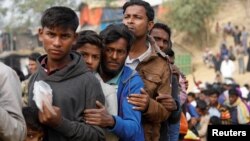The thundering crash of 60 mm artillery shells pounding down on Hauy Yao village is as clear as day for Shan refugee Lung Sai Lang, recalling the Sunday morning in 2002 when he grabbed his two young children and fled through the jungle to the Thai-Myanmar border with his wife.
“The Burmese troops thought that we civilians wanted to support the Shan army but actually we just wanted to live in peace,” recounts the 66-year-old rice farmer, who now resides at Kung Jor refugee camp in the mountainous border region.
The ruling Junta forces "scorched earth" campaign displaced over 300,000 ethnic Shan civilians from 1996 onward, with a campaign of terror and abuse to destabilize community support for opposing ethnic armed forces.
WATCH: Cycle of Military Violence Repeats in Myanmar
“Whenever we heard that the Burmese military were coming into our area, all the men disappeared while the women and the children stayed to make sure the soldiers didn’t steal their property,” recalled Sai Lang.
“When the Burmese army couldn’t get the men for forced labor or porters to carry their weapons in the jungle, the soldiers forced the women to go with them on patrols and many of the women were raped, many rapes,” Sai Lang explained, adding,“it was used as a way of humiliating us.”
Critics say instilling fear in the ethnic minorities has been practiced since the military coup in 1962, but documentation of the methodology was limited due to the country’s isolation from the rest of the world.
Then, in 2002, Shan Human Rights Foundation (SHRF) and the Shan Women’s Action Network (SWAN) investigated and published "License to Rape," documenting 173 incidents of rape and other sexual violence involving 625 girls and women, allegedly committed by the Myanmar army in Shan state, primarily between 1996 and 2001.
“This atrocity is considered a very shameful action. It’s used to terrorize and demoralize and humiliate the local communities and also to show that they can control the whole community,” explained Shan teacher and co-founder of SWAN Charm Tong.
“Our documentation shows that the Burmese army clearly used rape as a systematic weapon of war and during that time most of the perpetrators went unpunished and there was no justice for the women,” the 37-year-old humanitarian award winner added.
Despite the report drawing international attention to the issue of sexual violence in Myanmar’s conflicts, the army denied all claims of any wrongdoing, conducting their own internal investigation in August 2002.
Later, it was uncovered by the SHRF that the people of Central and Southern Shan State were forced by authorities to sign papers stating that no incidents of sexual violence had been committed by the army.
But brutal attacks by the military have continued over the years, displacing thousands more in Shan state and other ethnic areas, largely unreported because of the remote locations.
“The reality is the Myanmar military has sealed itself off from any sort of accountability, with its exertion of power and it’s willing to use violence to back up its prerogatives,” said Phil Roberston, deputy director of Human Rights Watch's Asia division.
“No state or national officials in the recent democratic era have been able to seriously challenge that reality. Only external pressure from the international community, threatening to take senior military commanders before an international court, has made any kind of appreciable impact on Tatmadaw attitudes,” Robertson added.
The allegations of the security forces’ practice of rape as a weapon of war continue to this day, now in Rakhine state against the ethnic Rohingya minority, where more than 650,000 people have fled the country into Bangladesh since Aug. 2017.
Hundreds of women and girls have retold horrific accounts of rape and sexual abuse, but the Myanmar military has restricted access for human rights groups to access witnesses and victims in the areas where the alleged attacks have occurred.
And once again, a recent military's internal probe claims that 2,817 people from 54 Rohingya villages were interviewed and findings concluded that its’ army did not rape or commit sexual violence against women.
“The fact that Aung San Suu Kyi and her government did not say a word when the Lt. General Aye Win issued his incredibly ridiculous report in November, denying all Tatmadaw atrocities in the clearance operations in Rakhine state, shows how weak national Burmese efforts have been to demand accountability,” Robertson said.
In fact, Aung San Suu Kyi proclaimed in 2011, “Rape is used in my country as a weapon against those who only want to live in peace, who only want to assert their basic human rights, especially in the areas of the ethnic nationalities,” during a speech at the Nobel Women's Initiative Conference in Montebello, Canada.
However, those words have yet to be repeated in response to the mounting accounts of rape of the Rohingya women during Myanmar military operations in Rakhine.
“Most of these attacks and offenses the violence committed by the Burmese military in a very systematic way in different parts of ethnic areas and I think it is time that the international community to stop being silent about all of these crimes and the impunity that has been committed for over 70 years,” said Charm Tong.
In the meantime, humanitarian aid agencies including the International Organization of Migration have set up safe zones offering support, including psycho-social services, and physical care for Rohingya women to visit inside the refugee camps near Cox’s Bazar.










